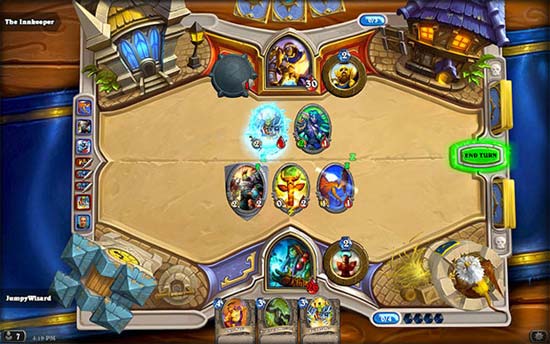Three years ago, I wrote up a somewhat positive review on the Hearthstone beta on the Pojo forums. And I’m going to revisit the topic today. I’m not involved in the competitive scene of Hearthstone, so this is more of an overview than a review.
A few years ago, Blizzard realized that their cash cow (World of Warcraft) was starting to decline and was not going to be around forever. So they made a smart decision to diversify their market and carve new niches. Among their new genres, Overwatch proved to be a success and an excellent game in the action genre. Hearthstone is also a success, competing against card games, a genre that did not have much competition in the video game world. There just aren’t many good card game video games out there (though I did enjoy both Baten Kaitos games for the Gamecube). The Magic and Yugioh video games have largely existed to promote their TCG’s, but Hearthstone was designed to be a TCG card game in itself. I may not have given it enough credit for its time, but it did fill a niche. Digital TCG’s which were both accessible and not a cheap internet flash game were relatively rare.
It’s definitely a clone of Magic the Gathering in nearly every sense, but it’s made simpler so that beginners can learn it in an hour rather than a week. Cards are moved automatically by the player’s instruction so the player can focus on making in-game decisions rather than worrying where each card goes. Card effects are simple enough to fit into a sentence, so the player doesn’t have to read long card texts. With a smaller hand size and card effects which often activate on their own, the player isn’t overwhelmed by too many decisions. To reduce any headaches on lands (how many to run, which to run, which to use, when you’ll draw them), Hearthstone steadily increases the player’s mana by 1 per turn to make it fair and reduce the player’s capability of building an imbalanced deck. Additionally, a less cluttered field means that the game is more playable on a 8” tablet.

Hearthstone uses 9 separate classes (each with a different focus) instead of 6 combinable colors like Magic; there’s less customization but also less room to combine colors in a way which may be overly risky or overpowered. In that sense, Yugioh has gone this route as well. Instead of 9 classes, there are dozens of archetypes; except each archetype has a smaller card pool and only a few archetypes are viable per format. To continue on the Yugioh comparison, Hearthstone is a reminder on how bare bones Duel Links is. While Duel Links has very little element of customization and strategy, Hearthstone does have a reasonable balance.
In my earlier review, I mentioned the positives of crafting, the smooth tutorial, a hassle-free interface, a colorful art style and a vibrant mood overall. Those aspects still hold up well today. The game has remained stable, the community grew and it’s a success. As far as the game being developed into something as deep as full-on TCG’s, not so much. But I can accept that this game was not designed for the minority of people who want to spend a large amount of time learning a deep card game. In bringing a TCG to the masses, Blizzard succeeds. However, the free to play model is still questionable (and not going away anytime soon thanks to its success).
At least it actually is free to play. Several of Yugioh and Magic games charge $15-20 for their game on top of wanting the player to purchase additional in-game cards. But, in a sense, free to play is unfortunately the only model for card games. I thought that Blizzard’s other new IP, Overwatch, was right in charging full price for the game, yet guaranteeing that each player gets the full gameplay experience. There’s a difference, however. An action game with a sizable budget is something people will pay full-price for. But a 2D card game is not something people would pay $40-60 for, at least at first. To get the majority of cards in Hearthstone, the player has to spend hundreds of dollars. Real-life TCG’s can get much higher, but paying hundreds for cards I can’t hold in my hand, trade and sell freely is a stretch. Originally, I thought Hearthstone’s model relied on millions of players spending a few dollars here and there. But now it seems like most of their money probably comes from people who are addicted to the game or strive to competitive; I guess it’s not that much different than Yugioh right now.



